| MUSEUM
Antique Rosaries |
HISTORY
of the Rosary |
for you index |
cord instructions |
LINKS |
EMAIL
US+
877 695 3561 |
MEDJUGORJE
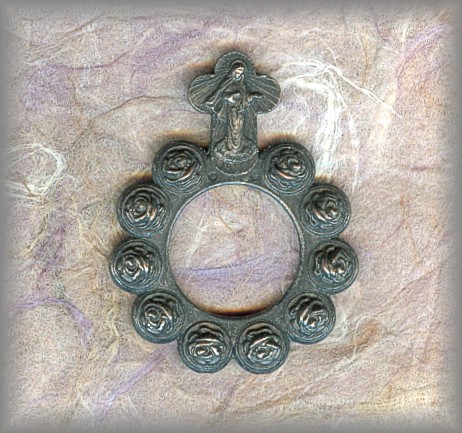
apparition / rosebuds (not available) |
SCENES
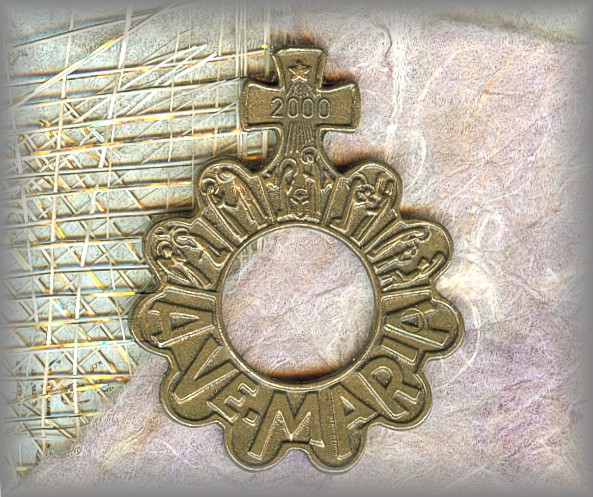
Ave Maria / rosary scenes (not available) |
FLEUR di LYS
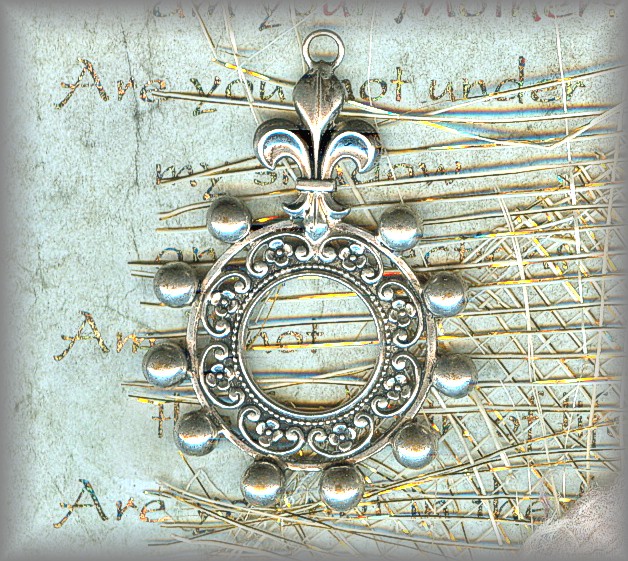
fleur dy lys ornate filigree (not available) |
CRUCIFIX / ROSES
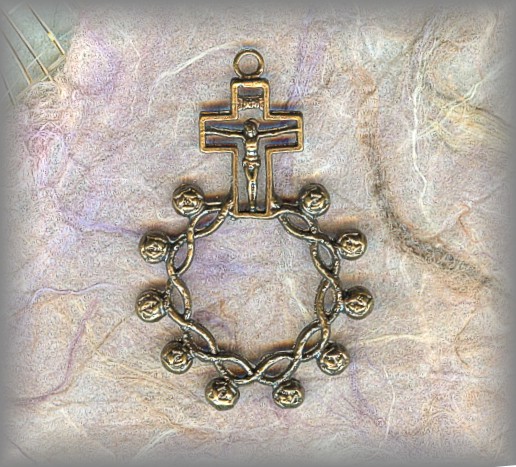
crucifix / crown of SS.ROS.001 |
CRUCIFIX
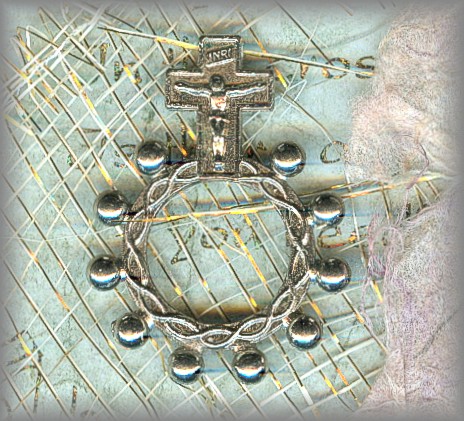
crucifix / crown of thorns (not available) |
|
+ THE BASQUE ROSARY RING Just about everyone we know has one of these rosary rings. They are great to keep in a pocket along with your loose change. But did you know they have a history that goes back to the 1500s? We recently purchased some ring rosaries that carried the term, 'Basque Ring Rosary' (Euskal arrosarioa) or 'Basque Rosary Ring'. .+ TWO RINGS ARE AVAILABLE AT THIS TIME. ONE ABOVE AND ALSO SEE 'BEZEL / SIGNET RINGS' (BELOW) |
|
SPAIN AND FRANCE I knew the Basque was a region in Spain but other than that, was totally oblivious to the history behind the ring. The challenge was encouraged by Chris Lanning of Paternoster Row so I began that great trip into history to find out more about what and where these terms came from. Thanks, Chris! + 10 'AVE' KNOBS So, what is a 'Basque Rosary Ring' or a 'Thumb Ring'? It is a flat ring with 10 prayer knobs, rosebuds or notches for the Ave's (Hail Mary). The Pater (Our Father) is prayed on either a cross or symbol at the top. To complete the 5 decades of the rosary, the Thumb Ring is moved from one finger to the next + ROOTS IN THE 1500s But where does the term, ‘Basque Rosary’ come from? It is a term that has its roots in the 1500s. The flat design shown here is more recent and now since the 20th century is growing in popularity to identify a prayer counter which is worn on the finger and called a Basque Rosary Ring. check out the following links
|
|
*COUNTRY / PEOPLE / FAITH* with images of the rosary mysteries |
|
The Basque Country is the region between Southwestern France and Northeastern Spain in the Pyrenees Mountains. 25 % of the people who live there still speak the Basque tongue. +
NO STRANGERS TO THE ROSARY It is believed that the practice of the Catholic Christian faith was introduced to the Basques around the third or fourth century and it lived side by side with local pagan customs for centuries. But the Basque people are no strangers to the rosary or its prayers, still saying it daily. + DEVOTED TO MARY They are very devoted to Mary and name their daughters after her and various apparitions such as Our Lady of the Pillar (Saragoza) and Our Lady of Carmel. They are daily communicants and make pilgrimages to holy sites frequently. |
|
*BASQUE (EUSKARA) LANGUAGE8 |
|
The language (Euskara), itself seems to have a mysterious root of origin, possibly Spanish, while others say it is a language ‘unto its own’. But many agree that it is the 'oldest language in Europe'. Some of the oldest traces of Euskara are found in inscriptions in Aquitaine. These ancient root words consist mostly of the names of persons and divinity, which are easily recognizable given modern Basque: An example would be Andere 'woman, lady', and Nescato 'maiden'. These are confirmed by adjectives and suffixes that they are part of the first written traces of Euskara, dating from the first centuries after Christ. More recently possibly because of the local apparitions, the term now reflects 'Our Lady' + THE LANGUAGE OF LOURDES We know Basque (Euskara) is the language or local dialect that Bernadette of Lourdes spoke and understood. It is also the language Mary spoke to Bernadette and the language Bernadette shared Our Lady's message in. |
|
*MARIAN APPARITIONS* |
|
RICH WITH VISITATION Many Marian apparition sites are in and near the Basque region (France and Spain), so it would be understandable that this name has an effect on and influenced the community, the language and terminology, that ‘Basque’ might apply to a rosary or prayer counter, especially when we read these thumb rosaries are 'still being used' in Spain. This suggests they have been around the area for awhile! +
MANY APPROVED APPARITIONS Some of the approved apparitions of ‘Our Lady’ in France and Spain are: Laus (1665), La Salette (1846), Lourdes (1858), Miraculous Medal (1830), Pontmain (1871 and in Spain: Zaragoza (40 ad), Garabandal (1961), and in nearby Portugal: Fatima (1917). Also in neighboring Belgium there are two: Banneux (1930’s) and Beaurang (1932). One above with 10 rosebuds and image of Medjugorje (1981 Bosnia Herzegovina and not an approved apparition ) is a pilgrimage souvenir but it shows how the term 'Basque Rosary Ring' has grown to represent other apparition sites. From ancient times rings also carried images of saints. |
|
*MARIAN INFLUENCE* |
|
MARY'S INFLUENCE TRAVEL FAR Traditionally, Catholicism is the faith of the people of the Basque and as you will see, Mary played a powerful role in their lives. The Jesuits owe their origin to two Basques, many famous Catholic Basques came to the Americas and brought home exciting news about 'New Spain'. This included Columbus discovering America, the apparition of Our Lady of Guadalupe and the visitations of Sor Maria Agreda to the Jumanos along our Rio Grande ... +
EXPLORERES, PRIESTS, BISHOPS ... Our Southwest was built by trails from one mission to another by many Basques and all this news traveled back from the explorers and Priests to the Bishops, the church and the people. Our Lady was in the midst of all this news about Colonial Spain and would influenced all who heard back home. |
|
(FRANCIS XAVIER / IGNATIUS OF LOYOLA) The Co-founders of the Society of Jesus, both Basques, Francis de Xavier (1506 - 1552) and Ignatius of Loyola (1491, 1556), both claimed to have been protected by the intercession of the Blessed Virgin Mary. Ignatius, during battle in her service as a Basque soldier - It was her intercession that inspired him to establish the religious order known as the Jesuits (The Soldiers of Christ.) + OUR LADY OF THE WAY The work of the Society of Jesus was to defend the Roman Catholic Church (Catholic Reformation) in response to the Protestant Reformation sparked by the former Roman Catholic priest Martin Luther (1483 - 1546). (See Wikipedia) Madonna Della Strada or Santa Maria Della Strada (Our Lady of the Way) is the patroness of the Society of Jesus. |
|
(COLUMBUS / CORTEZ / ZUMARRAGA) History tells us that the Basques explored and fished off of the coast of New Foundland long before the 1500s. On Columbus' first voyage (1492), 40 years before Our Lady of Guadalupe (1531) appeared, he renamed his Basque owned ship the 'Santa Maria' and his navigator was a Basque, Juan de Lakotsa. The crew of the 'Nina' is mostly Basque. + BASQUE SHIPS AND CREW His second voyage (1493) the 6 ships were Basque with 2 Basque captains as was much of the crew and by his third voyage (1494) they were almost all Basque. By the end of the century, Basques had monopolized the trade routes between Europe and New Spain with 184 ships. |
|
( TEXAS / NEW MEXICO / ARIZONA / CALIFORNIA ) In 1527, Spaniard Herman Cortez would command a fleet of Basque owned and manned vessels and ended up discovering Baja California. He carried with him mercenaries, most of whom were Basque. He went inland on his search for gold and discovered the land of the Aztecs (Mexico), eventually conquering Montezuma II who thought Cortez was the returning god Quetzecotal. Cortez brought with him Franciscan Friars who came to teach the indigenous about salvation. |
|
AND GUADALUPE ( A SECRET PRAYER ANSWERED ) By 1531 J Zum?rraga, a Basque Priest, was made first Bishop of Mexico. In the unrest of the times, he secretly prayed for a sign: Castilian Roses (Spain), unheard of in Mexico, especially in December. But an Aztec convert, Juan Diego, who had been visited by Our Lady, gave the Bishop his answer when Juan Diego opened his Tilma in front of the Bishop and rare Castilian Roses fell out. This in itself was a profound sign but when the miraculous image of Our Lady appeared on his Tilma, it became a turning point in the conversion of the Aztecs to Christianity, (over 3000 a day, in an 8 year period = 9 million conversions). + MARY, STAR of the NEW EVANGELIZATION - YEAR of FAITH 2013 Many full sized paintings (some actually traced from the original) were made of this miraculous image and sent back to the Spanish Bishops and the Basques who knew people involved first hand, were profoundly touched by Our Lady's presence to them. It is easy to understand why the Holy Father chose Our Lady of Guadalupe' as the 'Star of the New Evangelization.' During the Year of Faith (2013) |
|
( MARY LED THE WAY ) She would figure into the settling of the Southwestern part of our country in the following years as the Spaniards moved North from Mexico (New Spain), then West into Texas, New Mexico and Arizona. Eventually missions were built up the California Coast from what is now San Diego (1769) to Sonoma (1823). Basques were also very active in the missions in the Baja. |
|
We are told that some rare examples have more than ten knobs (adding one for a paternoster, one for a Credo). These appear to be from around the 1500s when rosary prayers and rosaries were standardized and carried a Credocruz. (To pray the Creed and ask for an increase of faith, hope and love). These bezels had images of saints. but from Tudor times the decoration was usually the engraved sacred monogram 'I H S', accompanied by a cross and three nails, but sometimes a crucifix. |
|
These 'Decade Rings' or 'Thumb Rings' also carry the title of 'Basque Rosary Ring'. But possibly not all that popular until about the time of the apparitions at Lourdes. These then appear to become pilgrimage souvenirs. (Terms are often very localized or regional and in mountainous areas do not move quickly.) The Pater (Our Father prayer) is a bezel or oval using a variety of religious, symbols, etchings or images of events and holy people, especially saints (similar to the flat rings above.) + 15C OR BEFORE 'Such rings are documented from the 15th century but are probably older. We mainly see them in the 17th and 18th centuries (particularly during the periods of Catholic persecution, being easier to conceal than a rosary), and they are still used in Spain.' From: An Illustrated Dictionary of Jewelry, author: Harold Newman, publishers: Thames and Hudson |
|
*PERSECUTION / HISTORY* |
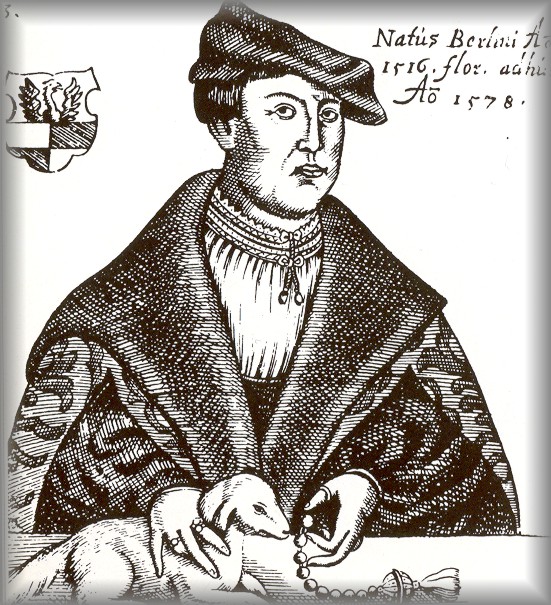 |
1578 WOODCUT
This German woodcut dated 1578 shows a man with one hand on a dog and the left hand praying on a 'Zehner' or a 'Tenner' (10 beads) ending in a tassel. Tassels on rosaries were symbolic of 'wiping away the tears of sin or sorrow'. (Notice the 'Thumb Ring' which is attached to the beads) |
|
This older style Ring is like the ones attached to 'Tenners' or 'Zehners' as seen in images from the 16th century. These rings are seen with and without the knobs (also see Der Rozenkranz - pg 463 ). They often have a small ring soldered outside to hold the beading cord or chain. + (GOING UNDERGROUND) When King Henry V111 tried to divorce his first wife, Katherine of Aragon of Spain (1485 - 1536 ), as she was unable to give him an heir, and the Catholic Church refused to grant his divorce, the King decreed the dissolution of the the church and started the Church of England. This set up the following persecution of Catholics in England which would last until about the mid 1700s. After that, these rings were made more for personal convenience than to avoid persecution. + THE LITTLE IRISH ROSARY Ireland also suffered under the hands of the English during these penal times and you see rings attached to a string of 10 beads. + Not only was all land and wealth belonging to Catholics in England and Ireland reclaimed or destroyed, Catholics were also killed for practicing their faith and were forced underground. Rosaries would be a powerful sign that one was a 'papist' Catholic so a small ring was developed that could be either attached to a strand of 10 beads (called a 'decade' rosary.) or worn alone. When these rings were attached to 10 beads, they were known as a 'Tenner' or in Germany, a 'Zehner' and in Ireland, 'An Paidrin Beag' or 'Little Rosary'. + When the Catholic Emancipation (1820s) took place, freedom of religion was restored to Great Britain by King Charles II and it was no longer necessary for people to hide from persecution. The concept of the Thumb Ring continued to be popular, so from their known manufacture in Great Britain (mid 16c) to today, they are still being made and used. |
|
*SYMBOLISM* |
|
APPARITIONS, CRUCIFIXES +
PILGRIMAGE SOUVENIRS These flat Rosary Rings or ‘Thumb Rings’ use variety of symbols including roses, fleur de lys, a crucifix, Our Lady (imaging various apparition pilgrimage souvenirs - more recently, Our Lady of Medjugorje, still carry the term 'Basque Rosary Ring) The knobs seem to range from balls and rosebuds to lettering. More and more they all seem to fall under the same standard category or name. |
|
*LAUBURU CROSS* BASQUE CROSS,
ANCIENT SNASKRIT CROSS The Ancient Sanskrit cross also represents 4 seasons, 4 winds, 4 elements. Basque Solar (sun) origin: feminine goddess obliquely transferring into 'Our Lady'. |
|
Let these old thumb rings and rosaries speak to you in their simplicity and elegance. Let the fingers count and the heart pray. And consider how Mary has worked in the hearts of the Basque people and how they have responded by giving her honor over the centuries, embracing her in their history for hundreds of years, possibly thousands! We leave it up to you! + FOR MORE INFORMATION: "The Koch Collection of Finger Rings," (vol.1, pg 246, fig 803) 'An Illustrated Dictionary of Jewelry' Harold Newman, publishers: Thames and Hudson 'Der Rozenkranz' Andacht Geschichte Kunst (pg 454) also see more information at google and wikipedia |
|
MISSION STATEMENT Our vision is to provide the finest handmade rosaries, chaplets and other fine religious art forms for personal worship we can make using the finest supplies available. The Guild believes the work of our hands should give visual Glory to God, therefore for us, the best for you is very, very important. +++ QUESTIONS? ask us: copy and paste beadsong@hotmail.com OR CALL WEEKDAYS - 9 to 5central 877.695.3561
MUSEUM
- HISTORY
- PRAYER
for more information
see
ROSARY
WORKSHOP - INSPIRED ZEHNERS
OFFICE
HOURS
|
|
secure-online - credit card -[or]- mail in - mo/personal check |